- by foxnews
- 09 Mar 2025
US firms exploiting Trump-era loophole over toxic ‘forever chemicals’
US firms exploiting Trump-era loophole over toxic ‘forever chemicals’
- by theguardian
- 13 Oct 2022
- in news

Chemical companies are dodging a federal law designed to track how many PFAS "forever chemicals" their plants are discharging into the environment by exploiting a loophole created in the Trump administration's final months, a new analysis of federal records has found.
The Fiscal Year 2020 National Defense Authorization Act put in place requirements that companies discharging over 100lb annually of the dangerous chemicals report the releases to the Environmental Protection Agency (EPA). But during the implementation process, Trump's EPA created an unusual loophole that at least five chemical companies have exploited.
The amount of PFAS being discharged into the air, water or disposed of on land "could be much higher than we already know", said Jared Hayes, a policy analyst with the Environmental Working Group (EWG) and a report co-author.
"Allowing manufacturers to skirt reporting requirements has serious public health consequences for communities that live near facilities that use PFAS and they have a right to know how many forever chemicals companies are releasing," he wrote.
PFAS are a class of about 12,000 chemicals typically used to make thousands of products resist water, stain and heat. They are called "forever chemicals" because they do not naturally break down, and accumulate in humans and the environment. A growing body of evidence links them to serious health problems like cancer, birth defects, liver disease and autoimmune disorders.
The chemicals are estimated to be contaminating drinking water for over 200 million people in the US, and state and federal regulators have passed a barrage of new legislation in recent years designed to rein in pollution.
Public health advocates say PFAS discharges from chemical plants have sickened residents living near or downstream from them. Contamination from a Chemours factory in North Carolina has contaminated hundreds of square miles around the facility, and DuPont paid $670m (�610m) for sickening thousands of residents near its West Virginia PFAS production plant.
EWG's analysis of federal reporting records identified five plants discharging unknown amounts of 14 PFAS compounds, though there may be more.
The Trump EPA gave PFAS an unusual exemption under the law that allows companies not to report discharges if the amounts are "negligible", which is defined as less than 1% of a total mixture. The rule is referred to as the "de minimis exemption".
Companies discharging thousands of pounds of PFAS could have gotten their releases under the 1% threshold via several routes, said Melanie Benesh, EWG's vice-president of government affairs. Companies may have added water to PFAS to dilute it to the point that it is below 1%. However, the total amount of PFAS released is still high, and may present a threat once in the environment.
Companies may also be using complex mixtures with multiple PFAS. If the companies keep any one PFAS compound below the 1% threshold, then they won't have to report it, even if the total amount of all PFAS compounds in the mixture far exceeds 1%.
"The reason we have the [reporting law] is so communities downstream from those facilities know what's in their water, so if you have companies that are avoiding reporting then it undermines the purpose of the law," Benesh said.
In a statement to the Guardian, an EPA spokesperson said the agency is aware of the loophole and has begun the process to potentially close it.
Benesh said she is uncertain why the Trump administration would agree to create the loophole, but noted that chemical companies or trade groups asked for the exemption during implementation's public comment. Meanwhile, the American Chemistry Council, a trade group representing companies that avoided reporting PFAS discharges, had lobbied the EPA office in charge of implementing the law.
The NDAA required companies managing and disposing of 180 different kinds of PFAS over 100lb (45kg) annually to report their releases to the EPA's toxics release inventory (TRI).
Separately, the chemical data reporting rule (CDR) already required companies that use PFAS in volumes more than 2,500lb (1,134kg) annually to report use data.
The EPA last year noticed companies that handled or produced large volumes of PFAS and reported to the CDR did nor report discharges under the TRI. Companies contacted by the agency cited the 1% de minimis exemption as the reason for not reporting.
Allowing PFAS to be exempted under de minimis is "clearly at odds with Congress's intent", Hayes wrote. Lawmakers intentionally set the 100lb (45kg)-reporting threshold because all substances with such low reporting levels are labeled "chemicals of special concern".
Manufacturers cannot use the de minimis exemption to avoid reporting releases of chemicals of special concern. But when the Trump EPA implemented the law, it did not include PFAS as a chemical of special concern, and instead gave it a designation with chemicals with reporting thresholds of 10,000 pounds or above, Hayes wrote.
PFAS are the only chemicals with a 100lb (45kg) reporting limit that can use the exemption.
"EPA's de minimis loophole gives companies an opportunity to keep their pollution secret, which goes against the very purpose of the toxic release inventory," said Tim Whitehouse, a former EPA attorney and executive director of Public Employees for Environmental Responsibility.
In a statement to the Guardian, the EPA said its proposed rule changes include removing the eligibility of the 1% exemption for PFAS, designating PFAS as a chemical of concern, and "reversing the approach set forth by the previous administration".
- by foxnews
- descember 09, 2016
'Speaker scum' on flights sparks debate among travelers: 'This is getting out of hand'
A traveler asked social media users to weigh in on flyers who play audio aloud on their devices and don't use headphones.
read more


